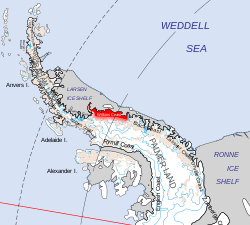Wilkins Coast: Difference between revisions
Created page with "{{territory|BAT}} '''Wilkins Coast''' is that portion of the east coast of the Palmer Land in the British Antarctic Territory stretching between Cape Agassiz and [..." |
No edit summary |
||
| (One intermediate revision by the same user not shown) | |||
| Line 1: | Line 1: | ||
[[File:Wilkins Coast.svg|right|thumb|250px|Location of the Wilkins Coast]] | |||
{{territory|BAT}} | {{territory|BAT}} | ||
'''Wilkins Coast''' is that portion of the east coast of the [[Palmer Land]] in the [[British Antarctic Territory]] stretching between [[Cape Agassiz]] and [[Cape Boggs]], including the west shore of Stefansson Sound. | '''Wilkins Coast''' is that portion of the east coast of the [[Palmer Land]] in the [[British Antarctic Territory]] stretching between [[Cape Agassiz]] and [[Cape Boggs]], including the west shore of Stefansson Sound. | ||
| Line 16: | Line 17: | ||
{{reflist}} | {{reflist}} | ||
*{{basgaz}} | *{{basgaz}} | ||
{{BAT coasts}} | |||
{{Catself}} | {{Catself}} | ||
[[Category:Coasts of Palmer Land]] | [[Category:Coasts of Palmer Land]] | ||
Latest revision as of 20:49, 19 July 2020

Wilkins Coast is that portion of the east coast of the Palmer Land in the British Antarctic Territory stretching between Cape Agassiz and Cape Boggs, including the west shore of Stefansson Sound.
This coast was named for Sir (George) Hubert Wilkins (1888-1958), the Australian polar explorer and pioneer air photographer, who in an Antarctic exploratory flight on 20 December 1928, flew southward from Deception Island and crossed the Antarctic Peninsula to its east side. He continued southward to Stefansson Strait and Hearst Island, which lie midway along the Wilkins Coast.
The coast was in part photographed from the air by Wilkins, 20 December 1928, and later named after him.
Wilkins was Second-in-Command, 1913-17, of the Canadian Arctic Expedition of 1913-18 and Second-in-Command in 1920 of the British Antarctic Expedition of 1920-22 under J. L. Cope; a member of the Shackleton-Rowett Antarctic Expedition of 1921-22. He was an organizer, with C.B. Eielson as chief pilot, of flights over the Arctic Ocean from Point Barrow, Alaska, culminating in the flight from there to Svalbard, 15-16 April 1928. Returning to the Antarctic, Wilkins was Leader of the Wilkins-Hearst Antarctic Expedition of 1928-29, with Eielson as pilot; the Wilkins Antarctic Expedition of 1929-30, with the Discovery Investigations ship William Scoresby as tender and S.A. Cheesman as pilot; Joint Leader with Lincoln Ellsworth of the Nautilus expedition of 1931, for submarine navigation north of Svalbard; Manager of flying operations on Ellsworth's Antarctic expeditions, 1933-34, 1934-35, 1935-36 and 1938-39; organizer, with H. Hollick-Kenyon as chief pilot, of flights over the Beaufort Sea in search of six missing Soviet airmen, 1937-38.
The whole coast was surveyed by the Falkland Islands Dependencies Survey, with assistance from the Ronne Antarctic Research Expedition, from "Stonington Island" in November 1947. The coast was further photographed from the air by the United States Navy, 1966-69.
Location
- Location map: 69°39’58"S, 63°0’0"W
References
- Gazetteer and Map of The British Antarctic Territory: Wilkins Coast
| Coasts of the British Antarctic Territory | |||
|---|---|---|---|
| Trinity Peninsula |
Graham Land: Nordenskjöld • Oscar II • Foyn • Bowman • Palmer Land: Wilkins • Black • Lassiter • Orville • Zumberge |
||
|
Graham Land: Davis • Danco • Graham • Loubet • Fallières • Palmer Land: Rymill • English |
|||